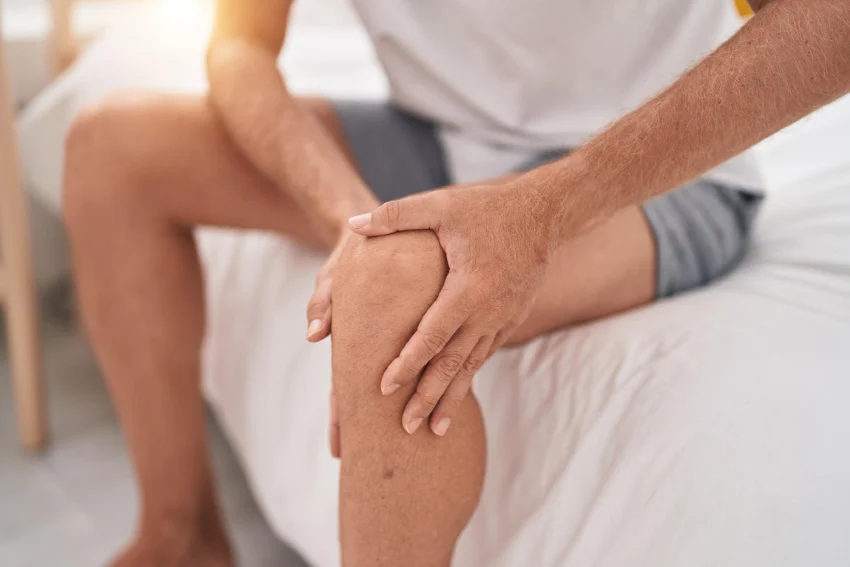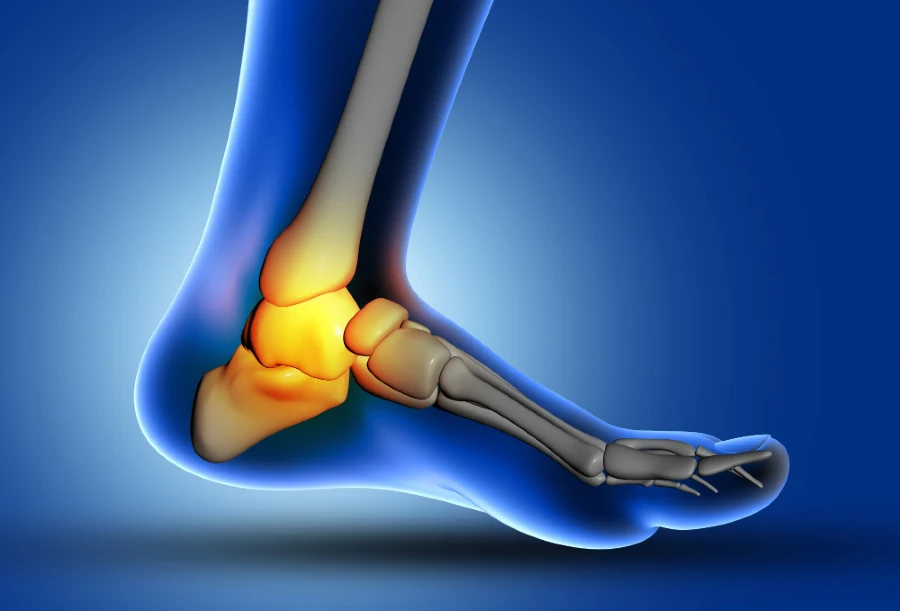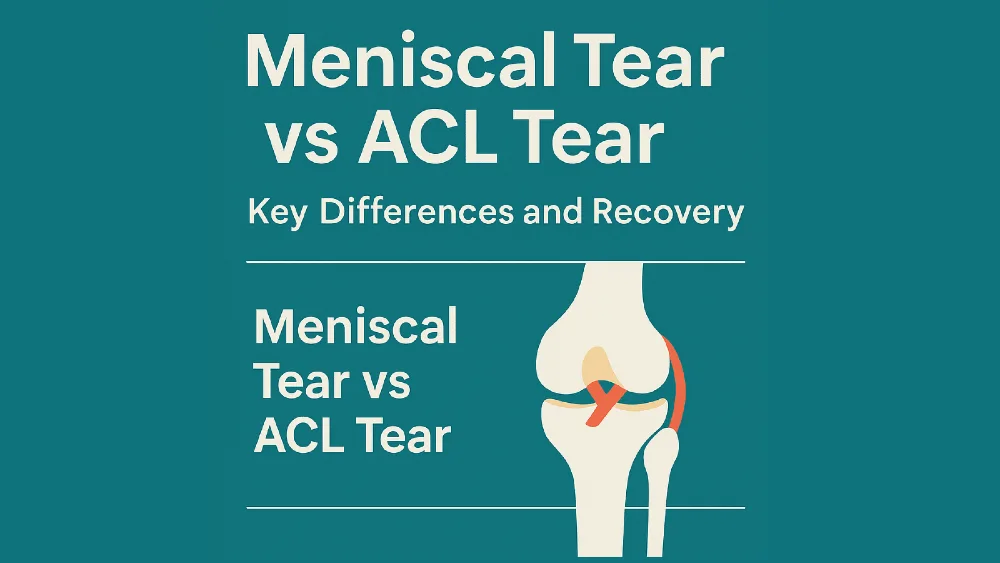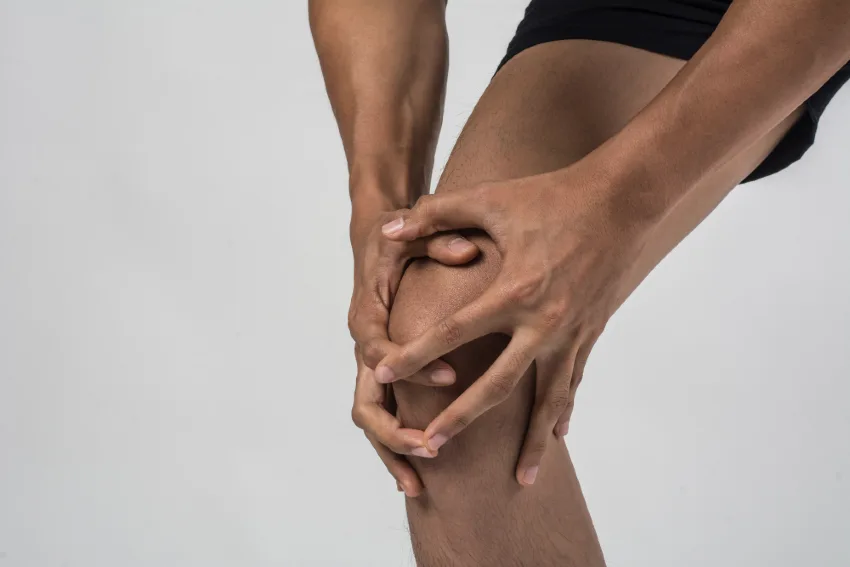Meniscus tears are one of the most common causes of knee pain and can result from either a sudden injury or gradual wear and tear over time. While traumatic tears often occur during sports or twisting movements, degenerative meniscus tears are more common in older adults, individuals with knee osteoarthritis, or those who are overweight.
The big question many people ask is: Will a meniscus tear heal on its own? The answer depends on several factors, including the type, location, and severity of the tear.
In this article, we’ll take a closer look at which meniscus tears might heal on their own, what factors influence the healing process, and what types of treatment are recommended in different scenarios—whether that means conservative care or surgical intervention.
Meniscus Anatomy and Function
The knee is a complex joint that connects the femur (thighbone) to the tibia (shinbone) and fibula (calf bone). Between the femur and tibia are two crescent-shaped cartilage structures known as menisci—the medial meniscus (inner side) and the lateral meniscus (outer side). These structures act as essential shock absorbers and stabilizers within the knee joint.
Composed mainly of water (around 72%) and a dense network of type I collagen fibers, the meniscus has a C-shaped appearance. However, its healing capacity is limited due to its poor blood supply. The outer edge of the meniscus—closest to the joint capsule—has better vascularization and therefore greater healing potential. In contrast, the inner portion receives minimal blood flow and relies on joint fluid diffusion, making it much more prone to injury and slower to heal.
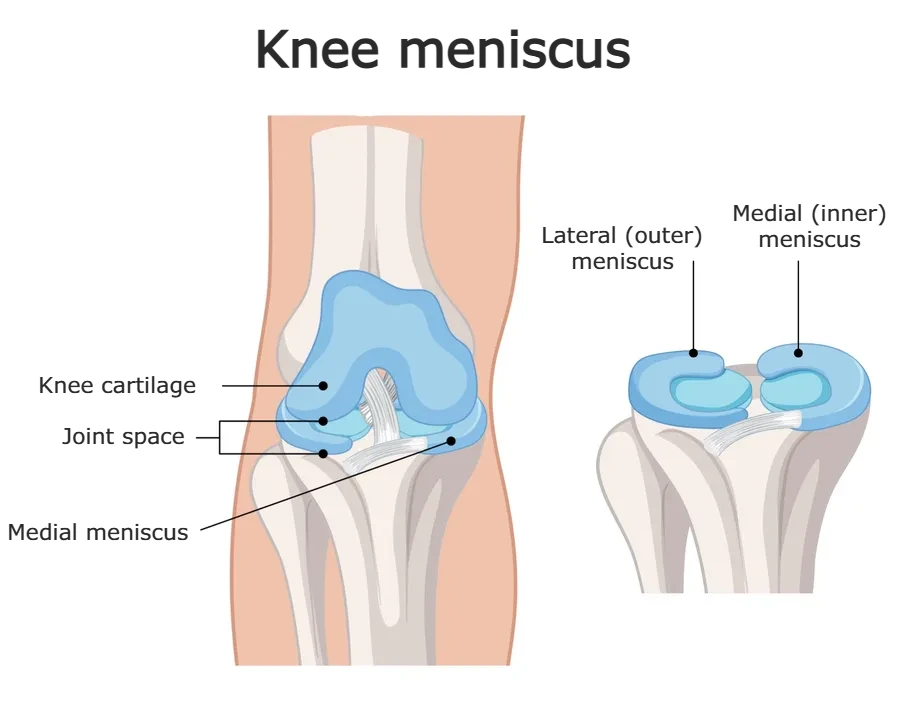
Each meniscus covers about 70% of the tibial surface, increasing the contact area between the bones. Their main roles include load distribution, shock absorption, reducing friction, and protecting the articular cartilage—functions that are vital for smooth, pain-free knee movement.
Acute vs. Degenerative Meniscus Tears
Now that we’ve covered the basic anatomy of the meniscus, let’s look at the two main types of meniscus injuries: acute tears and degenerative tears.
Acute meniscus tears are more common in people under the age of 40 and are often the result of sports injuries. Sports that involve rapid changes in direction or rotational movements—such as soccer, basketball, handball, or skiing—carry a higher risk. These injuries often occur alongside other knee damage, such as tears of the anterior cruciate ligament (ACL).
In contrast, degenerative meniscus tears are more frequently seen in individuals over the age of 40. These tears are caused by age-related weakening of the meniscal tissue, which becomes less elastic and more vulnerable to mechanical stress. Often associated with knee osteoarthritis, degenerative tears can occur with minimal or no trauma—sometimes even from simply standing up awkwardly or twisting the knee slightly. In fact, up to half of degenerative meniscus tears occur spontaneously, with patients often unaware of any specific injury event.
Types of Meniscus Tears
Meniscus tears are classified based on their shape and location, which can be accurately visualized using MRI (magnetic resonance imaging). This classification helps physicians assess the potential for spontaneous healing and determine the most appropriate course of treatment—whether conservative management or surgery.
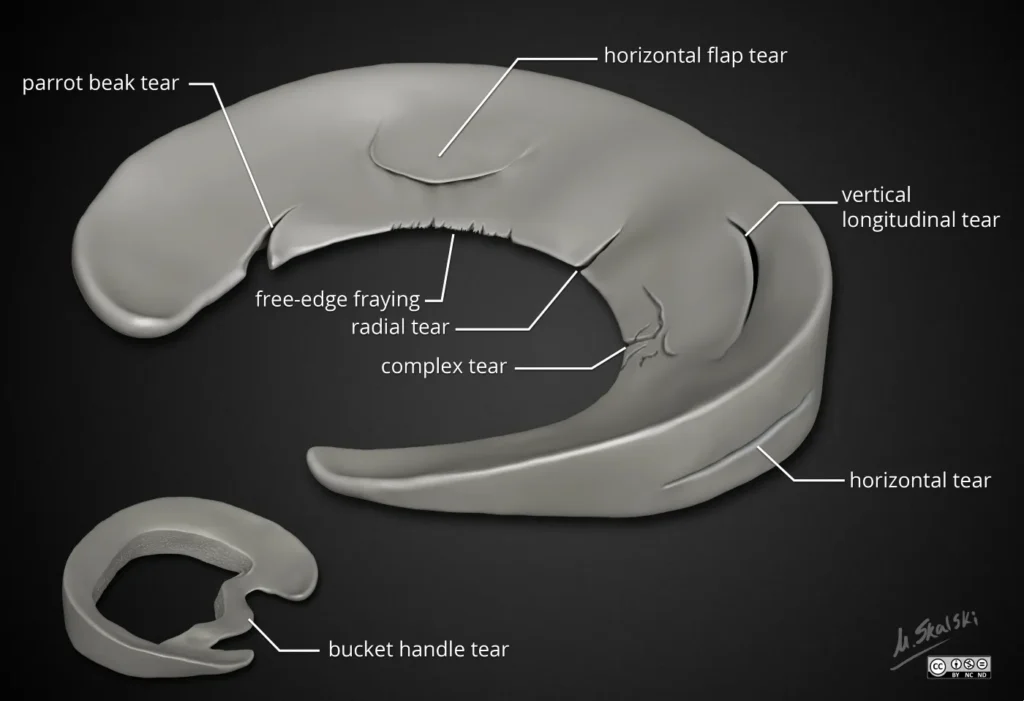
Understanding the type of tear is crucial, as some patterns—like radial or complex tears—are less likely to heal on their own, while others, particularly peripheral longitudinal tears, may respond well to conservative care.
Will a meniscus tear heal on its own?
After a meniscus injury, one of the first questions many people ask is: Do meniscus tears heal on their own without surgery? The honest answer is: it depends. Not all meniscus tears are the same, and whether one can heal on its own depends on several important factors—most notably, the location, type, and stability of the tear.
The outer edge of the meniscus—often referred to as the “red zone”—receives a good blood supply. Blood flow is essential for tissue healing. If the tear is located in this outer area and remains stable, it has a much better chance of healing on its own over time. In fact, clinical studies have shown that over half of such tears have healed naturally when monitored over time.
In contrast, the inner region of the meniscus—known as the “white zone”—has little to no blood supply. Tears in this zone typically do not heal on their own, simply because the body cannot deliver enough nutrients to support the repair process. This is especially true for radial and complex tears, which often disrupt the structural integrity of the meniscus.
Another important factor is whether the tear is degenerative or traumatic. Degenerative tears, which occur over time as the meniscus weakens, usually have limited healing potential—even if they’re small. On the other hand, traumatic tears, especially in younger individuals, may show better healing response if they are well-vascularized and not displaced.
In short, some meniscus tears can heal on their own, especially if they’re stable, small, and located in the outer vascular zone. However, others—particularly those in low-blood areas or with complex tear patterns—lack the biological conditions required for natural healing.
When Does a Meniscus Tear Require Surgery?
This topic has sparked much debate; however, when it comes to degenerative meniscus tears, the evidence appears quite clear.
Numerous scientific studies have shown that non-surgical treatment for degenerative meniscus injuries is equally effective as surgical intervention. Therefore, conservative treatment is recommended as the first-line approach for all patients over the age of 40 who present with a degenerative meniscus tear.
Surgery may be considered in cases where symptoms do not improve despite appropriate non-operative care.
On the other hand, acute meniscus tears are more commonly seen in younger individuals and are often linked to sports injuries. According to current literature, a similar non-operative-first approach is advised for these injuries as well—unless the knee is locked by a displaced meniscal fragment. In the absence of knee locking, it is generally recommended to try conservative treatment first, and if symptoms persist after 2 to 3 months of physical therapy, arthroscopic surgery may be considered.
How Long Does It Take for a Meniscus Tear to Heal?
The healing time for a meniscus tear depends on several factors, including the type of tear, the treatment approach, and your age and activity level.
If the tear is small and stable, located in the outer vascular zone, and treated conservatively, many people begin to feel better in 6 to 12 weeks with rest and physical therapy. However, full recovery can take longer—especially if you return to activity too soon.
For those undergoing surgical repair, initial healing usually takes about 6 weeks, but it may take 3 to 6 months before full return to sports or high-impact activities is advised. On the other hand, if part of the meniscus is removed (meniscectomy), recovery is often faster but may not offer the same long-term joint protection.
Regardless of treatment, following your doctor’s plan and progressing gradually is key to successful recovery.
Frequently Asked Questions (FAQ)
Does Every Meniscus Tear Cause Pain?
In short, no! Meniscus tears are often discovered incidentally on knee MRI scans. Their occurrence increases with age, regardless of symptoms. In fact, up to 60% of people who show a meniscus tear on MRI report no pain or discomfort at all.
Can I still walk with a torn meniscus?
Yes, many people can walk with a meniscus tear, especially if the tear is small or not causing locking. However, walking too much may increase pain or delay healing.
Does a meniscus tear always require surgery?
No. Many tears—especially degenerative or stable ones—can heal or improve with non-surgical treatment such as physical therapy, rest, and bracing.
Will continuing to exercise make it worse?
Possibly. High-impact activity or twisting motions can worsen a meniscus tear, especially if the knee is unstable or painful.
Can a meniscus tear heal completely?
Some tears, particularly in the outer third of the meniscus, can heal fully. Others may not heal but can become symptom-free with the right care.
Is it possible to prevent meniscus injuries?
While not all injuries can be avoided, strengthening the muscles around the knee, using proper technique, and wearing supportive shoes can help reduce the risk.
What Does a Torn Meniscus Look Like from the Outside?
From the outside, a torn meniscus may not always show obvious signs — especially in mild or chronic cases. However, in acute injuries, you might notice swelling around the knee joint within the first 24 to 48 hours. The knee may also appear slightly misshapen or puffy, particularly along the joint line. In some cases, the knee can look normal but still feel unstable, stiff, or painful when bending, squatting, or walking. Visible bruising is uncommon unless other structures, like ligaments, are also injured.
Yagishita K, Muneta T, Ogiuchi T, Sekiya I, Shinomiya K. Healing potential of meniscal tears without repair in knees with anterior cruciate ligament reconstruction. Am J Sports Med. 2004 Dec;32(8):1953-61. doi: 10.1177/0363546504263702. PMID: 15572327.
Fitzgibbons RE, Shelbourne KD. “Aggressive” nontreatment of lateral meniscal tears seen during anterior cruciate ligament reconstruction. Am J Sports Med. 1995 Mar-Apr;23(2):156-9. doi: 10.1177/036354659502300205. PMID: 7778698.
Ihara H, Miwa M, Takayanagi K, Nakayama A. Acute torn meniscus combined with acute cruciate ligament injury. Second look arthroscopy after 3-month conservative treatment. Clin Orthop Relat Res. 1994 Oct;(307):146-54. PMID: 7924027.
Weiss CB, Lundberg M, Hamberg P, DeHaven KE, Gillquist J. Non-operative treatment of meniscal tears. J Bone Joint Surg Am. 1989 Jul;71(6):811-22. PMID: 2745476.
Makris EA, Hadidi P, Athanasiou KA. The knee meniscus: structure-function, pathophysiology, current repair techniques, and prospects for regeneration. Biomaterials. 2011 Oct;32(30):7411-31. doi: 10.1016/j.biomaterials.2011.06.037. Epub 2011 Jul 18. PMID: 21764438; PMCID: PMC3161498.
Raj MA, Bubnis MA. Knee Meniscal Tears. [Updated 2023 Jul 17]. In: StatPearls [Internet]. Treasure Island (FL): StatPearls Publishing; 2025 Jan-.
Bhan K. Meniscal Tears: Current Understanding, Diagnosis, and Management. Cureus. 2020 Jun 13;12(6):e8590. doi: 10.7759/cureus.8590. PMID: 32676231; PMCID: PMC7359983.
Anderson AF, Irrgang JJ, Dunn W, Beaufils P, Cohen M, Cole BJ, Coolican M, Ferretti M, Glenn RE Jr, Johnson R, Neyret P, Ochi M, Panarella L, Siebold R, Spindler KP, Ait Si Selmi T, Verdonk P, Verdonk R, Yasuda K, Kowalchuk DA. Interobserver reliability of the International Society of Arthroscopy, Knee Surgery and Orthopaedic Sports Medicine (ISAKOS) classification of meniscal tears. Am J Sports Med. 2011 May;39(5):926-32. doi: 10.1177/0363546511400533. Epub 2011 Mar 16. PMID: 21411745.
Luvsannyam E, Jain MS, Leitao AR, Maikawa N, Leitao AE. Meniscus Tear: Pathology, Incidence, and Management. Cureus. 2022 May 18;14(5):e25121. doi: 10.7759/cureus.25121. PMID: 35733484; PMCID: PMC9205760.
Doral MN, Bilge O, Huri G, Turhan E, Verdonk R. Modern treatment of meniscal tears. EFORT Open Rev. 2018 May 21;3(5):260-268. doi: 10.1302/2058-5241.3.170067. PMID: 29951265; PMCID: PMC5994634.
Smoak JB, Matthews JR, Vinod AV, Kluczynski MA, Bisson LJ. An Up-to-Date Review of the Meniscus Literature: A Systematic Summary of Systematic Reviews and Meta-analyses. Orthop J Sports Med. 2020 Sep 9;8(9):2325967120950306. doi: 10.1177/2325967120950306. PMID: 32953923; PMCID: PMC7485005.
Mameri ES, Dasari SP, Fortier LM, Verdejo FG, Gursoy S, Yanke AB, Chahla J. Review of Meniscus Anatomy and Biomechanics. Curr Rev Musculoskelet Med. 2022 Oct;15(5):323-335. doi: 10.1007/s12178-022-09768-1. Epub 2022 Aug 10. PMID: 35947336; PMCID: PMC9463428.
Hohmann E. Treatment of Degenerative Meniscus Tears. Arthroscopy. 2023 Apr;39(4):911-912. doi: 10.1016/j.arthro.2022.12.002. PMID: 36872031.
Howell R, Kumar NS, Patel N, Tom J. Degenerative meniscus: Pathogenesis, diagnosis, and treatment options. World J Orthop. 2014 Nov 18;5(5):597-602. doi: 10.5312/wjo.v5.i5.597. PMID: 25405088; PMCID: PMC4133467.
Giuffrida A, Di Bari A, Falzone E, Iacono F, Kon E, Marcacci M, Gatti R, Di Matteo B. Conservative vs. surgical approach for degenerative meniscal injuries: a systematic review of clinical evidence. Eur Rev Med Pharmacol Sci. 2020 Mar;24(6):2874-2885. doi: 10.26355/eurrev_202003_20651. PMID: 32271405.
Simonetta R, Russo A, Palco M, Costa GG, Mariani PP. Meniscus tears treatment: The good, the bad and the ugly-patterns classification and practical guide. World J Orthop. 2023 Apr 18;14(4):171-185. doi: 10.5312/wjo.v14.i4.171. PMID: 37155506; PMCID: PMC10122773.
Dawson LJ, Howe TE, Syme G, Chimimba LA, Roche JJW. Surgical versus conservative interventions for treating meniscal tears of the knee in adults. Cochrane Database Syst Rev. 2017 Sep 7;2017(9):CD011411. doi: 10.1002/14651858.CD011411.pub2. PMCID: PMC6483631.
https://fizijatar.hr/koljeno/lijecenje-meniskusa-bez-operacije/

